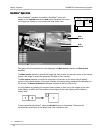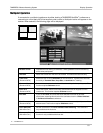
Advanced Use TANDBERG Director Videoconferencing System
56
Advanced call quality
TF - TANDBERG FIRST
Audio
AUTO The setting of ‘Audio: Auto/High/Normal’ in ‘Call Quality’ will be used.
G.722.1 Compressed high quality audio (7 kHz).
G.722 High quality audio (7 kHz).
G.728 Compressed normal quality audio (telephone quality, 3.1 kHz).
G.711 Normal quality audio (telephone quality, 3.1 kHz).
OFF No audio is transmitted.
Video
AUTO Optimized video quality depending on available bandwidth.
H.263 Bandwidth efficient video compression and decompression.
H.261 Normal video compression and decompression.
OFF No video is transmitted.
Resolution
AUTO The setting of ‘Video: Auto/Motion/Sharpness’ in ‘Call Quality’ will be used,
see tip above.
4CIF Digital Clarity
TF
(704 x 576 pixels), only
for H.263.
iCIF Natural Video
TF
(352 x 576 pixels for PAL,
352x480 pixels for NTSC), only for
H.263.
CIF High resolution video (352 x 288 pixels).
QCIF Low resolution video (176 x 144 pixels).
H.331
OFF Standard two-way communication with quality negotiation between both sides.
ON Used when broadcasting a video conference from one site to many others, e.g.
via satellite, where there is no possibility to negotiate quality between the
receivers and the originator due to one-way communication.
Status Format
Provides call quality feedback on the status line.
AUTO Video off/on; Audio off/normal/high
ADVANCED Shows video/audio standards (Example: Video: H.261 CIF, Audio: G.722).
NOTE
THE SELECTIONS MADE IN THIS
MENU
WILL OVERRIDE THE
SELECTIONS
MADE IN THE ‘CALL
QUALITY’ MENU. IF ‘AUTO’ IS
SELECTED
, THE SETTINGS IN
‘CALL QUALITY’ WILL BE USED.
TIP
RESOLUTION, AUTO
FUNCTIONALITY
(IF SUPPORTED
BY
FAR END):
WHEN ‘VIDEO: MOTION’ :
LOW BANDWIDTHS: CIF, SIF
HIGH BANDWIDTHS: ICIF, ISIF
WHEN ‘VIDEO: SHARPNESS’ :
CIF, 4SIF, VGA, SVGA, XGA**


















